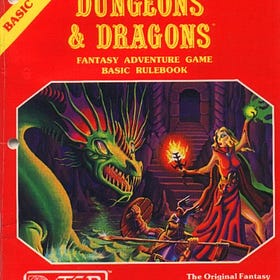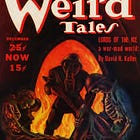Happy Belated Birthday to C.L. Moore: Collaborator and Visionary Extraordinaire

He lay there unquietly for a long while, turning the unanswered questions over and over in his mind. There was something about this crystal cube out of the unmeasured past, perhaps from the dawn of all history, that constituted a challenge that would not let him sleep. — C.L. Moore
“The Challenge from Beyond” (Full Text Link)
The short paragraph above marks the last sentence in Catherine Lucille Moore’s section of the shared universe tale The Challenge from Beyond (Reference Link at REH World). The story was published in Fantasy Magazine in the September 1935 issue and is a collaborative story that brought together the talents of Catherine Lucille Moore, Abraham Merritt, Howard Philips Lovecraft, Robert E. Howard, and Frank Belnap Long. The magazine and story were edited by Julius Schwartz who had recently founded the Solar Sale Service literary agency with his friend Mort Weisinger. The Solar Sale Service agency was the first agency to be devoted to science fiction writers and included Alfred Bester, Leigh Brackett, Ray Bradbury, H.P. Lovecraft in the long list of clients.
The magazine and issue are a major pillar in the foundations of both the science fiction genre and the comic book industry. It was no accident that Moore was the entry author to The Challenge from Beyond. Her ability to set up a tale is evident to any fan of her writing. Pick a tale. From her solo authored Jirel of Joiry and Northwest Smith stories to collaborations with her husband Henry Kuttner like “Mimsy Were the Borogoves,” you are drawn in from the opening sentence. She is an author with a distinctive voice and I was first introduced to that voice thanks to the bibliography Lake Geneva’s Children’s Librarian Barbara Davis put together for the Moldvay/Cook edition of the D&D Basic set.
My Taste in Literature was Shaped by a Game Designer and a Librarian
As James Maliszewski-- author of the underappreciated science fiction role playing game Thousand Suns -- has pointed out, the Appendix N that Gary Gygax provided on page 224 of the 1st Edition Advanc…
I selected the quote above because as much as I love Catherine Lucille Moore’s solo work, and I’ll be including links to my almost completed engagements with her Northwest Smith stories at the bottom of this post, she was also one of the great collaborators in the history of fiction and the opening epigraph demonstrates exactly why. She knew how to write in a way that inspired others to follow her lead. She simultaneously engages the reading mind and the creative mind. That’s a rare gift among writers, but it is one that she honed to mastery. She was a real life collaborator/mentor to Forrest Ackerman in the story “Nymph of Darkness” where she allowed him to Acker-out while still guiding him toward a better tale than his teenage mind would have mustered.
She wrote prolifically with her husband Henry Kuttner until he died in 1958 and it is a testimony to the strength of her writing that we recognize her solo written tales as her own, even as we recognize that once they began partnering no Kuttner tale was truly solo. One of my favorite Kuttner stories, The Dark World, almost certainly includes Moore’s contributions. One cannot read Moore’s other tales and not see echoes and style components on page after page. Moore’s name is included in the B/X Additional Reading for a very good reason. Her her ability to inspire the creative mind was one of the inspirations behind the way I play and think of Dungeons & Dragons, and I find it serendipitous that the largest role playing game convention now takes place in the city where she was born on January 24, 1911.
Happy belated birthday Catherine and thank you for all the great writing and all the inspiration you provided.
I’ve read and reacted to six of C.L. Moore’s tales of Northwest Smith and I find them to be wonderful examples of the Weird Tale genre and of early twentieth century fantasy. As we’ve entered the post-Tolkien era too much fantastic literature has become an echo of the Oxford scholar and too little has looked at the fantastic from fresh perspectives. Moore’s writing combines Planetary Romance, Lovecraftian Weirdness, Classical Mythology, and Westerns to create tales that are truly unique. They also resonate with subtexts that I touch on, but that deserve more attention. I would find it very interesting to read analysis that compared the themes in Moore’s work to those in Jane Austen and the Bronte sisters writings.











Kuttner's name was Henry, not Frank.
For fans of Mimsy Were the Borogoves,
there was a movie adaption in 2007 - The Last Mimzy
https://en.wikipedia.org/wiki/The_Last_Mimzy